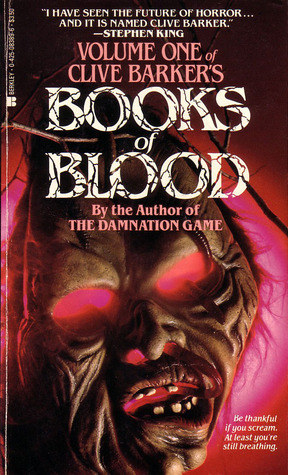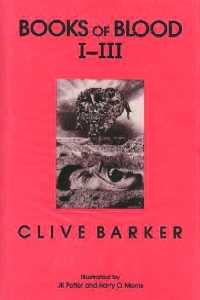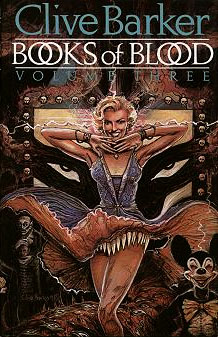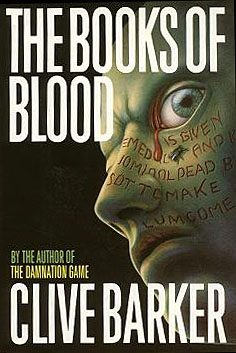 It was sometime in 1986 that a certain horror-obsessed pre-teen—me, to be exact—came across a paperback entitled VOLUME ONE OF CLIVE BARKER’S BOOKS OF BLOOD. Issued by Berkeley, it was an ugly little book, with a garishly lit witch mask cover photo and the ridiculous tagline “Be thankful if you scream. At least you’re still breathing.” Nonetheless, two things immediately struck me: (1). The writer was a complete unknown yet his name was used in possessory above-the-title fashion, and (2). Stephen King provided a most amazing (and, it turned out, inaccurately rendered) blurb: “I have seen the future of horror…and it is named Clive Barker.”
It was sometime in 1986 that a certain horror-obsessed pre-teen—me, to be exact—came across a paperback entitled VOLUME ONE OF CLIVE BARKER’S BOOKS OF BLOOD. Issued by Berkeley, it was an ugly little book, with a garishly lit witch mask cover photo and the ridiculous tagline “Be thankful if you scream. At least you’re still breathing.” Nonetheless, two things immediately struck me: (1). The writer was a complete unknown yet his name was used in possessory above-the-title fashion, and (2). Stephen King provided a most amazing (and, it turned out, inaccurately rendered) blurb: “I have seen the future of horror…and it is named Clive Barker.”
What I didn’t realize was that the six volume BOOKS OF BLOOD had already made a massive splash in the horror world. Its initial publication was in the UK in 1984, via paperback versions of the first three volumes from Sphere, followed by a hardcover omnibus from Widened & Nicolson the following year. 1985 also marked the first appearance of volumes 4-6, as well as a US hardcover edition of the first three volumes (with copious photographic illustrations by the great J.K. Potter) from the late Scream/Press, and the Berkeley paperbacks that marked my first exposure to the infernal brilliance of the first three BOOKS OF BLOOD.
For the record, volume four was released in the US as THE INHUMAN CONDITION and volume five as IN THE FLESH, while volume six initially saw print on these shores in a volume that included Barker’s novella CABAL. Since then the BOOKS OF BLOOD have gone through numerous printings (some with cover illustrations by Barker himself) and inspired a series of elegantly rendered comic book adaptations. More recently, the BOOKS OF BLOOD’S opening story “The Book of Blood” was adapted to the Madefire Motion Books format (essentially a moving comic book), with further tales set to follow.
Initial reactions to BOOKS OF BLOOD were generally enthusiastic, albeit overly focused, I feel, on the stories’ graphic content. Certainly the BOOKS OF BLOOD were quite bloody, indeed ground-breakingly so for the mid-1980s, which has led them to be wrongly lumped in with splatterpunk texts like Skipp & Spector’s THE LIGHT AT THE END and Ray Garton’s LIVE GIRLS—good novels both, but neither can match, or frankly even approach, the accomplishment of BOOKS OF BLOOD.
For that matter, in the ensuing 30 years I’d say Barker’s masterwork has only grown more unique, as the idea of an anthology by a first-time author issued as a multi-volume set seems even more outrageous now than it did back in ‘84. Furthermore, no short story collection published since has matched BOOKS OF BLOOD in audacity, ambition or linguistic brilliance.
Clive Barker’s prose style, which debuted fully formed in BOOKS OF BLOOD, is one that I feel doesn’t receive nearly enough recognition. It has an elegance and refinement redolent of a much earlier era, yet with a very modern love of physical description, especially when it comes to the freakish and grotesque. As Barker cheekily proclaimed in a 1985 interview, “I like to be able to deliver the vileness…Whether it be sexual subject matter, whether it be violence, I’m going to show it as best I can.” Barker’s prose is also quite reader-friendly, with a formidable grasp of storytelling mechanics and an imaginative joy that offsets the grimness of the tales. Quite simply, these stories are fun.
I’ll acknowledge there are shortcomings to be found in the youthful Barker’s writing. An overabundance of colons and semi-colons is evident in several of the stories, as are distracting viewpoint shifts. Even more damaging are the oft-perfunctory characterizations, which is something that continues to haunt Clive Barker’s work. It’s no secret that Barker is far more interested in monsters and fantasy landscapes than he is in human beings, resulting in personality-free protagonists who exist primarily to unleash the monsters.
Yet the imaginative fecundity of these stories is awe-inspiring, and remains unprecedented. See the fabled “In the Hills, the Cities,” which contains some of the genre’s most indelible imagery. “Rawhead Rex” is a blast of old-fashioned B-movie fun spiced with new-fashioned grotesquerie (don’t let the crappy movie adaptation put you off). “Son of Celluloid” provides a poisoned love letter to the movies in the form of a haunted revival theater whose movie-spawned ghosts are given form by a dying man’s cancer. The infamously splatterific “Midnight Meat Train” is also worthy, if a bit overly reminiscent of John Shirley’s 1982 novel CELLARS (one of Barker’s attributes is that his stories generally don’t recall anything else). “Dread” is among the most horrific and disturbing of BOOKS OF BLOOD’S tales, all the more so because it’s the only one devoid of supernatural elements. “New Murders in the Rue Morgue” is a witty updating of Poe, and “The Age of Desire” a suitably pervy account of the ultimate aphrodisiac.
Lesser entries include the silly “Hell’s Event,” the confused “Scape-Goats” and “Revelations” (in which Barker’s  aforementioned sudden viewpoint shifts grow especially annoying), yet the feverish invention and storytelling wizardry that characterize all these tales are very much in evidence. Truly, there’s not a single clunker to be found in BOOKS OF BLOOD’S six volumes.
aforementioned sudden viewpoint shifts grow especially annoying), yet the feverish invention and storytelling wizardry that characterize all these tales are very much in evidence. Truly, there’s not a single clunker to be found in BOOKS OF BLOOD’S six volumes.
In the succeeding years Barker has made a name for himself in the movie, comic and video game industries, and has published several more books. Most of those publications have been bulky fantasy epics far removed from BOOKS OF BLOOD, while more overtly horrific offerings like CABAL, THE HELLBOUND HEART and MISTER B. GONE are essentially glorified BOOKS OF BLOOD entries—and there’s certainly nothing wrong with that!
